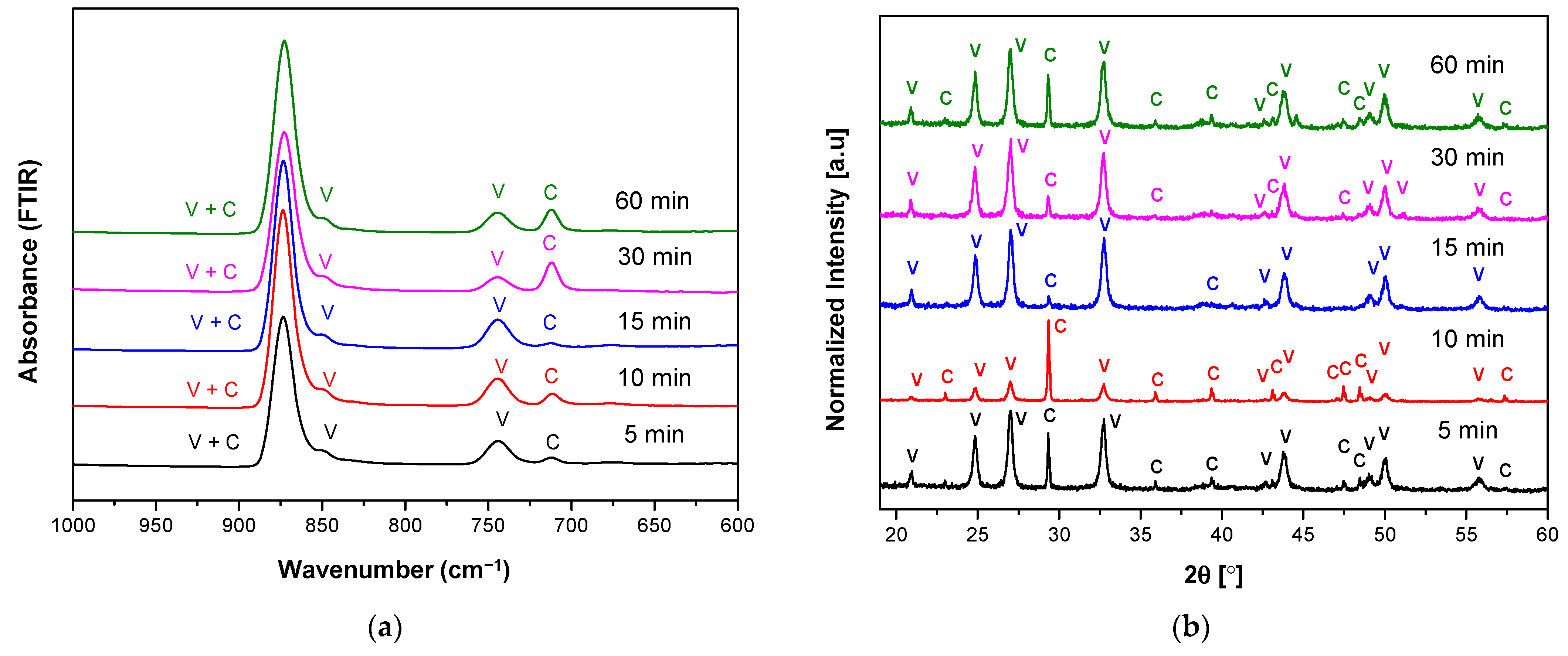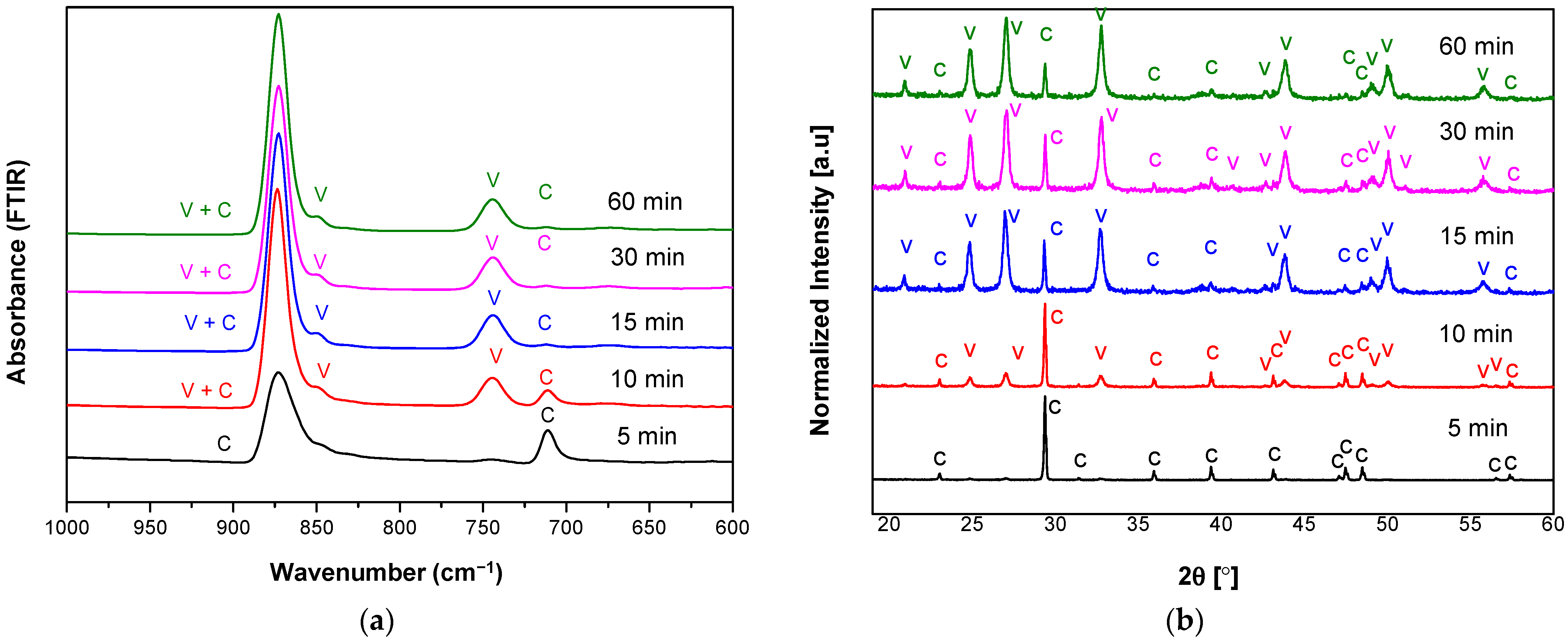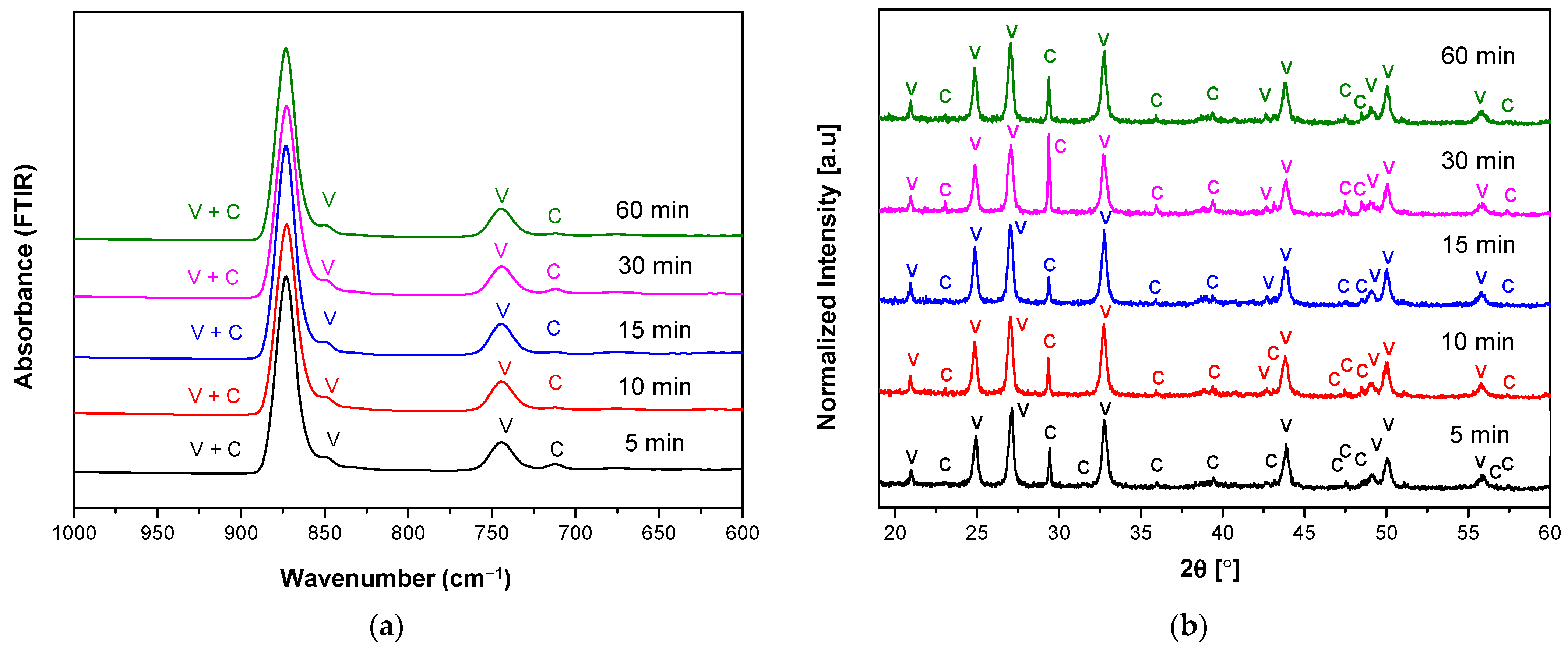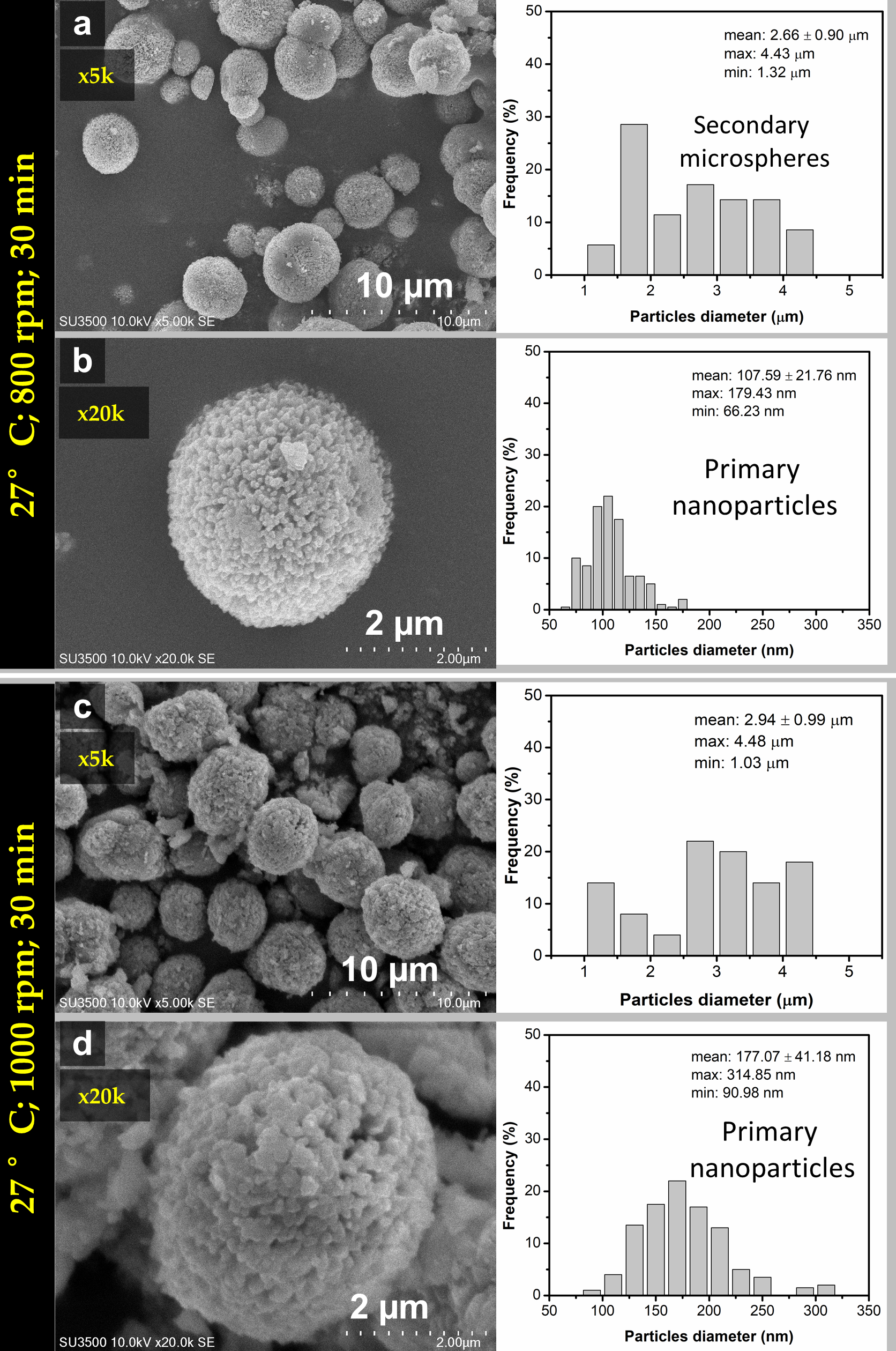3.1. The Characteristics of Porous CaCO3 Microsphere
Figure 2 and
Figure 3 show FTIR and XRD spectra of the prepared carbonate polymorphs as a function of reaction time where their absorption is indicated by V (vaterite) and C (calcite) at temperature 20 °C and different stirring speeds (800 and 1000 rpm). Fourier Transform Infrared spectroscopy was used to track changes in carbonate-related vibrational modes in three different CaCO
3 polymorphs (calcite, aragonite, and vaterite). One carbonate ion can have four normal modes: symmetric stretching, out-of-plane bending, asymmetric stretching, and in-plane bending [
8,
27]. The results showed the characteristic absorption band of vaterite at 849 cm
−1, 877 cm
−1, and 744 cm
−1 and absorption bands of calcite at 877 cm
−1 and 712 cm
−1. Overlapping of vaterite and calcite absorption bands were present at 877 cm
−1.
Considering only characteristics of active carbonate modes, the in-plane bending mode shows the most pronounced changes as a function of reaction time at a particular temperature and stirring speed. We have shown that spontaneous precipitation of calcium carbonates from moderately or low supersaturated (S ≤ 1) solutions led to the initial formation of vaterite and calcite. The FTIR spectra in
Figure 2a show that lower intensity of the calcite absorption band is obtained at reaction time from 5 to 15 min. These results indicated that at this condition (temperature 20 °C and stirring speed 800 rpm), crystals mainly consist of vaterite and calcite present as a minor phase. However, the presence of calcite was increased at the reaction duration of 30 and 60 min. This result is evidence of precipitate instability of ACC formation to form the vaterite phase at lower temperatures and lower stirring speed. The stirring speed created hydrodynamic conditions of ions and molecules, promoting collisions or diffusion of the vaterite crystal with intense contact with the solution. Therefore, much amount of vaterite transformed into calcite upon increasing their reaction time (30–60 min). However, the kinetics of the process was also to be dependent on the ionic strength of the solution. Three possible kink sites occur to be a calcium site ≡CO
3Ca
+, a carbonate site ≡CaCO
3− or a bicarbonate site ≡CaHCO
3°. A step at the calcite surface advances or retreats through the addition or loss of calcium and (bi-) carbonate ions at growth sites. To maintain crystal stoichiometry, the net rates at which calcium and (bi-)carbonate ions are incorporated at kink sites must be equal.
The corresponding XRD pattern also confirmed that the obtained CaCO
3 polymorphs were a mixture of calcite and vaterite (
Figure 2b). The characteristic peaks and hkl plane (
Table 1) of calcite were detected at 29.32°, 35.90°, 39.36°, 47.47°, 48.43°, and 57.37°; meanwhile, peaks of vaterite were detected at 20.89°, 24.82°, 26.99°, 32.72°, 43.71°, 49.07°, 50.06°, and 55.74°. Like the FTIR observation, high vaterite with the lowest calcite peaks was observed for the reaction time of 15 min. The calculated percentage of calcite and vaterite phases of CaCO
3 polymorphs were shown in
Table 2. A high percentage vaterite phase (97.1%) was obtained or present in the mesocrystalline with the lowest crystallite size (23.90 nm). Thus, both XRD and FTIR analysis showed that at the reaction time of 15 min received the highest vaterite phase and calcite present as a minor phase and also a relatively high percentage of vaterite (95.3%) at reaction time 30 min with crystallite sized 23.91 nm. A higher percentage of calcite (37.8%) in reaction times of 10 min compared to 30 min (4.7%) can be accepted due to its higher peak intensity of 877 cm
−1 in the FTIR result, which confirmed its presence in the higher calcite phase. Unlike the stirring speed 800 rpm, upon the increase of stirring speed (1000 rpm), the FTIR spectra (
Figure 3a) showed the highest calcite absorption band at 712 cm
−1 indicated the highest percentage of calcite phase in the CaCO
3 polymorphs for the reaction time 15 min. This analysis is also supported by the XRD observation, where their corresponding higher calcite peaks were obtained at 15 min (
Table 3). The higher stirring speed creates higher hydrodynamic conditions of ions and molecules improved possibility of collisions of the vaterite crystal with intense contact with the solution caused the enhanced amount of vaterite transformed into calcite. Generally, the result on varying the stirring speed at temperature 20 °C appeared to vaterite as the major component of CaCO
3 polymorphs, but still unstable phase due to moderate supersaturation at low temperature (20 °C).
The sample at reaction time 30 min was further investigated by SEM and TEM due to its relatively small crystallite size compared to others. The spherical morphology of CaCO
3 was obtained for the sample at the reaction time of 30 min at two different stirring speeds as shown in
Figure 4a–d. The CaCO
3 particles formed secondary microspheres with nanosize primary spherical particles. The size distribution analysis showed that the average size of microsphere was about (2.91 ± 1.06) μm for the stirring speed of 800 rpm (
Figure 4a), and about (2.47 ± 0.85) μm for the stirring speed of 1000 rpm (
Figure 4c). The average size of the primary particles were (153 ± 27.95) nm (
Figure 4b) and (171.29 ± 36.61) nm (
Figure 4d) at corresponding stirring speed 800 and 1000 rpm. For the stirring speed 800 rpm, the morphology was denser and more spherical compared to the morphology at stirring speed of 1000 rpm, relatively irregular in shape. This was due to the higher percentage of the vaterite phase in the sample (up to 95.3%). At the same reaction time, the average size of the microsphere was higher at stirring speed 800 compared to 1000 rpm. This means that the growth rate of the microsphere is faster at lower speeds. Thus, it was emphasized that at higher stirring speed received smaller microsphere particles due to higher speed may prevent adsorption of the nanoparticle suspension in the process of spherulitic growth to form larger incorporation of nanoparticles in the presence of centrifugal force. However, when the stirring speed increased, the motion of ions and molecules improved caused increasing the chances of collision and increasing the rate of vaterite active interaction with foreign ions in the solution promoted phase transformation of vaterite to calcite as shown in SEM images
Figure 4c which is highlighted in the circle. This picture is in agreement with the previous FTIR and XRD analysis in
Figure 2 and
Figure 3. Generally, all obtained sample at 20 °C undergoes phase transformation of vaterite metastable state. Thus, further study was extended for the higher temperature (27 °C) to see the phase transformation, morphology, and porosity of the obtained porous particles and investigate their formation mechanism.
In contrast to the FTIR and XRD analysis of the sample obtained at 20 °C, lower calcite phase formation as a function of reaction times at temperature 27 °C as shown in
Figure 5 and
Figure 6. It was highlighted that at stirring speed 800 rpm, the calcite phase indicated in peak absorption was reduced significantly as a function of times. However, at the beginning of the reaction, calcite formation dominates over vaterite (reaction time ≤ 5 min) at a lower stirring speed (800 rpm). It was highlighted that at the temperature of 27 °C appeared to vaterite as the major component of CaCO
3 polymorphs, with metastable phase due to higher supersaturation compared to temperature 20 °C.
The XRD pattern of polymorphs was shown in
Figure 5b, along with their attribution of the main peaks. From the XRD patterns, the characteristic peaks corresponding to vaterite were dominant as the reaction time increased, which was confirming that a higher temperature of 27 °C can also inhibit the transformation of vaterite to calcite. The detailed quantitative results based on XRD analysis were listed in
Table 4 and
Table 5. According to the calculation, the crystallite sizes of microspheres were calculated as 29.94, 26.25, 26.00, 23.92, and 25.08 nm, respectively (
Table 4). This showed that the crystallite size tends to decrease with the increase of reaction times from 5 to 60 min (at the temperature of 27 °C and stirring speed of 800 rpm). The peaks corresponding to calcite were much narrower than those of vaterite, confirming a larger crystallite size.
The XRD result confirming the FTIR spectroscopy, when the sample was stirred under 800 rpm at 5 min, only calcite was obtained, and the crystallite size was higher (29.94 nm). When the reaction time increased, the crystallite size was decreased to 25.08 nm as the percentage of calcite was decreased (
Table 4). It was seen from the XRD pattern, that vaterite percentage was increased and much metastable vaterite crystal was obtained as the increase of reaction time. When the samples were mixed under a stirring speed of 1000 rpm, the calculated crystallite sizes were 25.11, 22.99, 24.33, 22.58, and 23.90 nm, respectively (
Table 5). This showed that the crystallite size decrease with the increase of reaction time from 5 to 60 min (at the temperature of 27 °C and stirring speed of 1000 rpm). However, based on the calculated mean of crystallite size showed all value was not significant and in agreement with result previously reported research [
30]. This means the selected experimental condition revealed the crystallite size relatively homogeneous and also similar morphology observed in the SEM images.
SEM images of the samples mixed at 27 °C under stirring speeds of 800 rpm and 1000 rpm for 30 min reaction time were shown in
Figure 7a–d along with their 5 and 20k magnification. It was observed from the size distribution that microspheres average size were (2.6 ± 0.9) μm (
Figure 7a) and (2.94 ± 0.99) μm (
Figure 7c) corresponding for stirring speed 800 and 1000 rpm. These microspheres consisted of primary nanosize particles with average size (107.59 ± 21.76) nm and (177.07 ± 41.18) nm respectively for stirring speed 800 rpm (
Figure 7b) and 1000 rpm (
Figure 7d). The only small amount of calcite was present in the sample and relatively spherical. More spherical vaterite was obtained under stirring speed of 800 rpm compared with stirring speed 1000 rpm. TEM analysis also confirmed the morphology of obtained vaterite microstructure, as shown in
Figure 8a–d. The TEM images revealed the CaCO
3 microsphere consisted of many agglomerated primary nanosize particles with relatively homogeneous in size around 150 nm.
To analyze the total surface area of vaterite particles, multipoint BET measurement was conducted, as shown in the second column of
Table 6. The results showed that the specific surface area is greatly affected by the stirring speed. The specific surface decreases when the stirring speed increased. The BJH (Barret, Joyner, and Halneda) method was conducted to calculate the pore surface area, volume, and diameter from experimental isotherm using adsorption and desorption technique. Only BJH desorption results are shown in the table. The result showed that only stirring speed affects the surface area of the CaCO
3 polymorphs. The pore surface area, volume, and diameter remain the same with the increase of temperature. This indicated that the temperature difference between 20 °C and 27 °C did not affect their surface area. Meanwhile, when the stirring speed increased, the surface area and pore diameter were decreased, but the pore diameter was increased. This might be due to the diffusion of NaNO
3 from the solution to the microsphere trapped during the spherulitic process.
3.2. The Proposed Mechanism of Spherulitic Growth of CaCO3 Mesoporous
The mechanism of the ACC to vaterite formation is still under development, revealed with three main proposed mechanisms or models. The first proposed mechanism starts by dissolving ACC to form spherical vaterite by homogeneous nucleation of crystalline vaterite nanoparticles, and consequently, vaterite nanoparticles aggregate very rapidly to form the polycrystalline microsphere [
31,
32,
33]. Second, ACC particles are dehydrated and recrystallized to form vaterite [
34,
35]. Third, continuous dissolution of ACC and spherulitic growth formation of vaterite microsphere [
36,
37,
38,
39,
40]. Therefore, in this study, we investigated the effect of temperature and stirring speed as a function of reaction times on the phase transformation vaterite crystals, morphology, and also polycrystalline pore structure. It was explained by considering the mechanism of the vaterite crystallization by introducing a discussion on the recent proposed model crystal growth mechanism. One of the outstanding results of this study was the formation of porous particles without any additional porogen or template and interestingly using a simple mixing method. The kinetic formation of vaterite in the presence of various ions and molecules represents an intermediate step in the reaction pathway that leads from ACC to vaterite following Ostwald’s steps rule [
36]. The most important one was the mechanism on the formation of the porous formation of polycrystalline microsphere without additional porogen or template. The formation of porous polycrystalline vaterite was markedly different from the conventional particle to particle formation in which nucleation occurred.
The process involved mixing a precursor of Na
2CO
3 as the source of CO
3 and Ca(NO
3)
2·4H
2O source of Ca prepared at the condition of supersaturation concerning the initial precursors results in the formation of amorphous calcium carbonate (ACC) which later transform into vaterite crystal. Many factors influence the precipitation of calcium carbonate polymorphs, one of the most determinant factors was the presence of foreign ions (Ca
2+, Na
+, CO
32−) or molecules (NaNO
3) in the aqueous solution from which the carbonate precipitates. The proposed chemical reaction for the used precursors Na
2CO
3 and Ca(NO
3)
2·4H
2O are presented in Equations (1)–(3) and excess of NaNO
3 molecules in the solution (Equation (2)). The complete chemical reaction was presented in Equation (3).
We proposed the mechanism of polycrystalline vaterite microsphere formation at temperature 27 °C based on the FTIR, XRD, SEM, and TEM observations, as illustrated in
Figure 9. Immediately after mixing the precursors, nucleation of Ca
2+ and CO
32− ions occurred spontaneously in supersaturation solution to form clustered of primary vaterite crystals transformation to growth. The vaterite crystals are fully formed at near-equilibrium saturation conditions. On the other hand, Ostwald ripening of the small nanocrystallites is formed as the result of the internal crystal structure changing over time. Smaller nanocrystals divorcement due to a total contact area reduction with a solvent causes the growth of larger ones. That formation above occurred continuously with the fast spherulitic growth of vaterite crystal to form a mesocrystalline vaterite microsphere via growth front nucleation (GFN) mechanism [
38,
39].
The primary vaterite crystals have a secondary structure called polycrystalline, which is composed of nanocrystallites that have a size in the range of nanometers [
41]. Na
+ and NO
3− ions could be adsorbed in the original primary vaterite nanosize particles surface inside the microsphere and consequently prevent the crystal growth polymorph and phase transformation. A similar mechanism was reported using Na
2CO
3 as a carbon source that ions such as NH
4+ ions are able to control the growth of primary particles [
42]. In this case, the particle growth mechanism of spherulites of vaterite was found to be dependent on the crystal surface structure. The GFN mechanism mostly produced polycrystalline sphere contained crystalline nanosphere with similar in size. This is in agreement with the morphology observed in SEM and TEM images (
Figure 7 and
Figure 8). The presence of excess NaNO
3 molecules in the solution may be diffused inside of the microsphere during spherulitic growth and has a significant role for the mesocrystalline particles. In this condition, the trapped NaNO
3 diffusion prevented primary particles from becoming new crystals in secondary size during the formation of spherulites of the vaterite microsphere [
41]. Thus, pore mesocrystalline microsphere was obtained with relatively similar pore size which was consistent with the observation of their morphology in SEM and TEM images (
Figure 7 and
Figure 8) and BET of pore size in
Table 6. Thus, the presence of the NaNO
3 acting as porogen in microsphere during spherulitic growth was able to control the crystal porosity without the addition of any chemicals. Therefore, the obtained microspheres represent a very important biomaterial for various biomedical application such as bone substitute, i.e., our future development of CaCO
3 vaterite based scaffold.
















